springcloud starter(一)
Spring Cloud - Getting Started Example,
转载自:https://www.logicbig.com/tutorials/spring-framework/spring-cloud/hello-world.html
Following is a quick-start example of Spring Cloud. We are going to develop very simple microservices using Spring Cloud, Spring Boot and Eureka Server.
In microservice architecture, an application is composed of loosely coupled small services as opposed to a single monolithic application.
In microservice architecture a registry service is used to register the microservices so that they can be discovered.
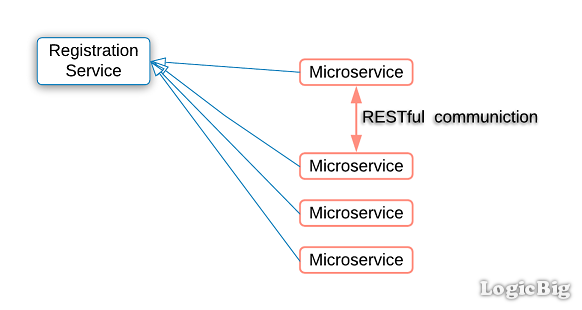
Example
In this example we are going to use Eureka Server as the service registry. Eureka is developed by Netflix; it is open source. Spring has integrated Eureka into dedicated Spring Cloud modules to make it easier to use it.
We are going to develop two microservices:
First is 'hello-service' which will just return a hello message.
Second service 'hello-web-client-service' will handle the request coming from a client. On receiving a request it will call 'hello-service' and will return a web page in response.
There will be three separate servers; one for Eureka and two of microservices. Also there will be three separate maven projects.
Eureka Server
Maven dependencies
pom.xml
<project .....>
<modelVersion>4.0.0</modelVersion>
<groupId>com.logicbig.example</groupId>
<artifactId>hello-eureka-server</artifactId>
<version>1.0-SNAPSHOT</version>
<parent>
<groupId>org.springframework.boot</groupId>
<artifactId>spring-boot-starter-parent</artifactId>
<version>2.0.4.RELEASE</version>
</parent>
<properties>
<java.version>1.8</java.version>
</properties>
<dependencies>
<dependency>
<groupId>org.springframework.cloud</groupId>
<artifactId>spring-cloud-starter-netflix-eureka-server</artifactId>
</dependency>
</dependencies>
<dependencyManagement>
<dependencies>
<dependency>
<groupId>org.springframework.cloud</groupId>
<artifactId>spring-cloud-dependencies</artifactId>
<version>Finchley.SR1</version>
<type>pom</type>
<scope>import</scope>
</dependency>
</dependencies>
</dependencyManagement>
</project>
Configuration
src/main/resources/application.yml
server:
port: 7777
eureka:
instance:
hostname: localhost
client:
registerWithEureka: false
fetchRegistry: false
In above configuration, the properties eureka.client.* are related to the service clients who want to register with Eureka.
The property eureka.client.register-with-eureka=false specifies that this server should not be registered to the service client itself.
The property eureka.client.fetch-registry=false specifies that the server should not fetch the registered information to itself.
Main class
@SpringBootApplication
@EnableEurekaServer
public class HelloEurekaServerMain {
public static void main(String[] args) {
SpringApplication.run(HelloEurekaServerMain.class, args);
}
}
Run above main class from your IDE. That will start the Eureka Server.
Now we can access the Eureka server at http://localhost:7777 as shown:
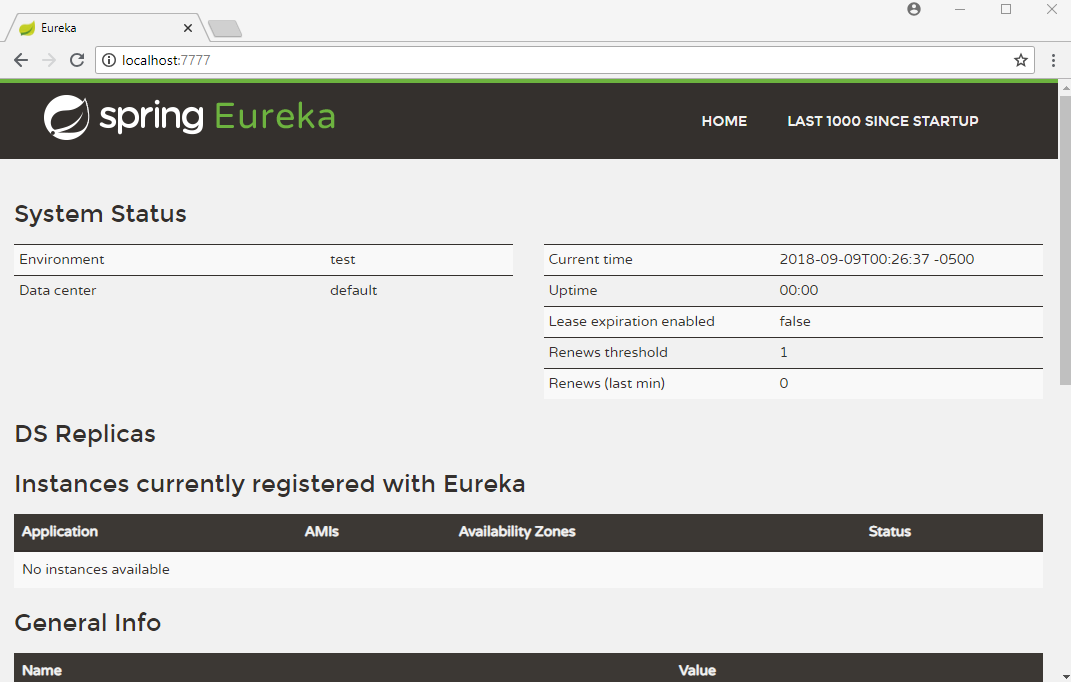
hello-service
Maven dependencies
pom.xml
<project .....>
<modelVersion>4.0.0</modelVersion>
<groupId>com.logicbig.example</groupId>
<artifactId>hello-service</artifactId>
<version>1.0-SNAPSHOT</version>
<parent>
<groupId>org.springframework.boot</groupId>
<artifactId>spring-boot-starter-parent</artifactId>
<version>2.0.4.RELEASE</version>
</parent>
<properties>
<java.version>1.8</java.version>
</properties>
<dependencies>
<dependency>
<groupId>org.springframework.boot</groupId>
<artifactId>spring-boot-starter-web</artifactId>
</dependency>
<dependency>
<groupId>org.springframework.cloud</groupId>
<artifactId>spring-cloud-starter-netflix-eureka-client</artifactId>
</dependency>
</dependencies>
<dependencyManagement>
<dependencies>
<dependency>
<groupId>org.springframework.cloud</groupId>
<artifactId>spring-cloud-dependencies</artifactId>
<version>Finchley.SR1</version>
<type>pom</type>
<scope>import</scope>
</dependency>
</dependencies>
</dependencyManagement>
</project>
Domain object
public class HelloObject {
private String message;
public String getMessage() {
return message;
}
public void setMessage(String message) {
this.message = message;
}
}
A Rest Controller
@RestController
public class HelloController {
private AtomicLong counter = new AtomicLong(); @GetMapping("/hello")
public HelloObject getHelloWordObject() {
HelloObject hello = new HelloObject();
hello.setMessage("Hi there! you are number " + counter.incrementAndGet());
return hello;
}
}
src/main/resources/application.properties
eureka.client.serviceUrl.defaultZone=http://localhost:7777/eureka/
src/main/resources/bootstrap.properties
spring.application.name=hello-service
Boot main class
@SpringBootApplication
@EnableDiscoveryClient
public class HelloServiceMain{ public static void main(String[] args) {
SpringApplication.run(HelloServiceMain.class, args);
}
}
Run above main class from your IDE.
On refreshing Eureka page you should see HELLO-SERVICE instance listed in the registry:
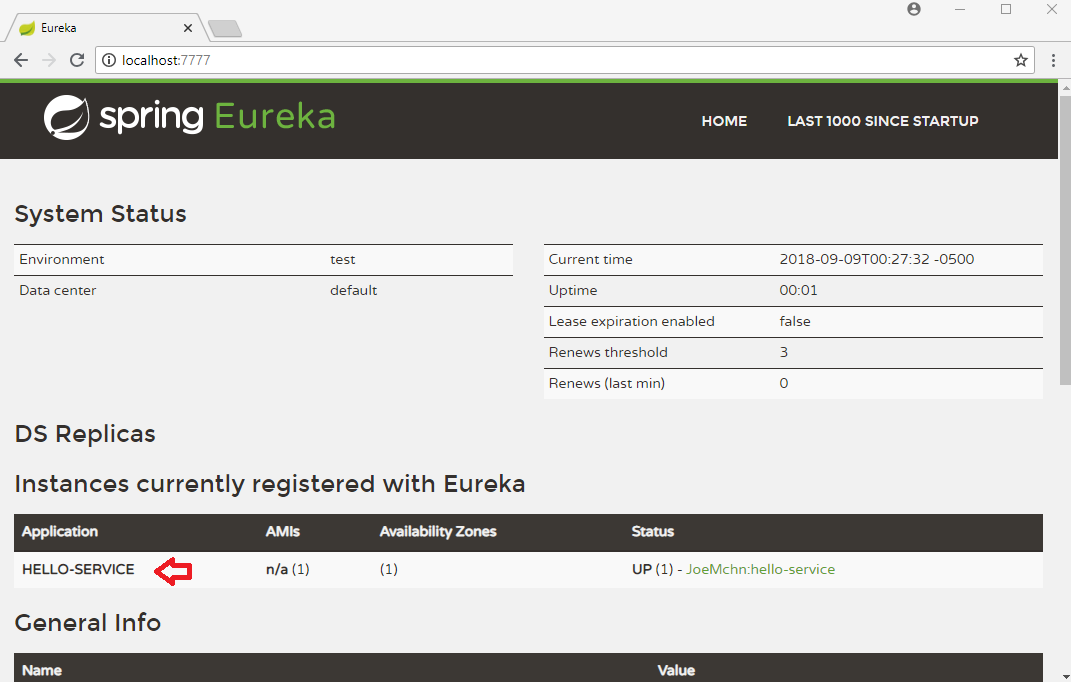
hello-web-client-service
pom.xml
<project .....>
<modelVersion>4.0.0</modelVersion>
<groupId>com.logicbig.example</groupId>
<artifactId>hello-web-client-service</artifactId>
<version>1.0-SNAPSHOT</version>
<parent>
<groupId>org.springframework.boot</groupId>
<artifactId>spring-boot-starter-parent</artifactId>
<version>2.0.4.RELEASE</version>
</parent>
<properties>
<java.version>1.8</java.version>
</properties>
<dependencies>
<dependency>
<groupId>org.springframework.boot</groupId>
<artifactId>spring-boot-starter-web</artifactId>
</dependency>
<dependency>
<groupId>org.springframework.boot</groupId>
<artifactId>spring-boot-starter-thymeleaf</artifactId>
</dependency>
<dependency>
<groupId>org.springframework.cloud</groupId>
<artifactId>spring-cloud-starter-netflix-eureka-client</artifactId>
</dependency>
</dependencies>
<dependencyManagement>
<dependencies>
<dependency>
<groupId>org.springframework.cloud</groupId>
<artifactId>spring-cloud-dependencies</artifactId>
<version>Finchley.SR1</version>
<type>pom</type>
<scope>import</scope>
</dependency>
</dependencies>
</dependencyManagement>
</project>
A Spring MVC Controller
@Controller
public class HelloWebClientController {
@Autowired
private DiscoveryClient discoveryClient; @GetMapping("/")
public String handleRequest(Model model) {
//accessing hello-service
List<ServiceInstance> instances = discoveryClient.getInstances("hello-service");
if (instances != null && instances.size() > 0) {//todo: replace with a load balancing mechanism
ServiceInstance serviceInstance = instances.get(0);
String url = serviceInstance.getUri().toString();
url = url + "/hello";
RestTemplate restTemplate = new RestTemplate();
HelloObject helloObject = restTemplate.getForObject(url,
HelloObject.class);
model.addAttribute("msg", helloObject.getMessage());
model.addAttribute("time", LocalDateTime.now());
}
return "hello-page";
}
}
c/main/resources/templates/hello-page.html
<!DOCTYPE html>
<html xmlns="http://www.w3.org/1999/xhtml"
xmlns:th="http://www.thymeleaf.org"> <body>
<h2>Hello Page</h2>
<div th:text="${msg}"/>
<div>Time: <span th:text="${time}"/></div>
</body>
</html>
src/main/resources/application.properties
server.port=9080
eureka.client.serviceUrl.defaultZone=http://localhost:7777/eureka/
src/main/resources/bootstrap.properties
spring.application.name=hello-service
Boot main class
@SpringBootApplication
@EnableDiscoveryClient
public class HelloWebClientServiceMain { public static void main(String[] args) {
SpringApplication.run(HelloWebClientServiceMain.class, args);
}
}
Run above class from your IDE.
Refresh Eureka web page again:
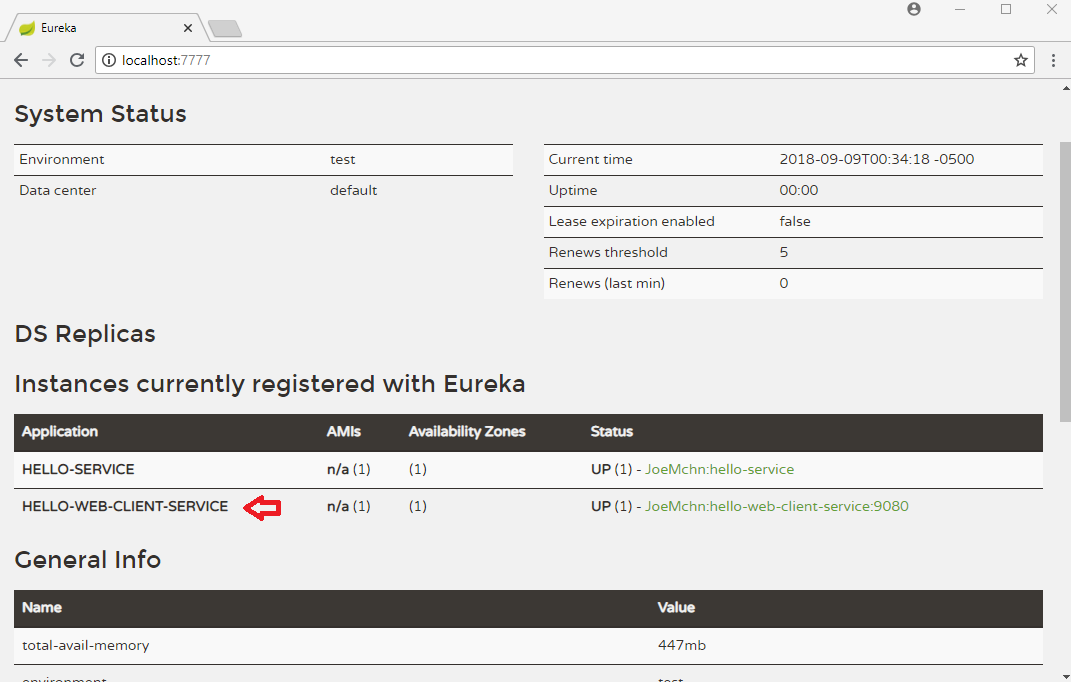
Final output
Now make request to 'hello-web-client-service' by entering localhost:9080 in web-browser:
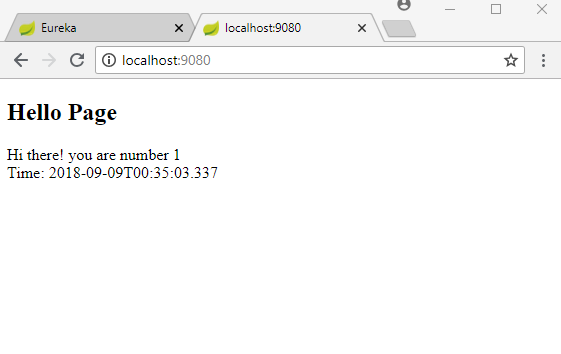
Example Project
Dependencies and Technologies Used:
- Spring Boot 2.0.4.RELEASE
Corresponding Spring Version 5.0.8.RELEASE - Spring Cloud Finchley.SR1
- spring-cloud-starter-netflix-eureka-server 2.0.1.RELEASE: Spring Cloud Starter Netflix Eureka Server.
- spring-boot-starter-web : Starter for building web, including RESTful, applications using Spring MVC. Uses Tomcat as the default embedded container.
- spring-cloud-starter-netflix-eureka-client 2.0.1.RELEASE: Spring Cloud Starter Netflix Eureka Client.
- spring-boot-starter-thymeleaf : Starter for building MVC web applications using Thymeleaf views.
Uses org.thymeleaf:thymeleaf-spring5 version 3.0.9.RELEASE - JDK 1.8
- Maven 3.5.4
springcloud starter(一)的更多相关文章
- spring boot:使用分布式事务seata(druid 1.1.23 / seata 1.3.0 / mybatis / spring boot 2.3.2)
一,什么是seata? Seata:Simpe Extensible Autonomous Transcaction Architecture, 是阿里中间件开源的分布式事务解决方案. 前身是阿里的F ...
- 极速体验|使用 Erda 微服务观测接入 Jaeger Trace
在大型网站系统设计中,随着分布式架构,特别是微服务架构的流行,我们将系统解耦成更小的单元,通过不断的添加新的.小的模块或者重用已经有的模块来构建复杂的系统.随着模块的不断增多,一次请求可能会涉及到十几 ...
- SpringCloud接入EDAS——服务发现篇
旁白 很久没有写技术文章了,最近不是写水文就是写小说.说到底,还是最近很少研究技术的缘故,已经到了江郎才尽的地步了. 不过,LZ无意间看到自己团队的小伙伴写的一些文章,觉得还是不错的,于是便动了心思, ...
- Spring SpringMVC SpringBoot SpringCloud概念、关系及区别
一.正面解读: Spring主要是基于IOC反转Beans管理Bean类,主要依存于SSH框架(Struts+Spring+Hibernate)这个MVC框架,所以定位很明确,Struts主要负责表示 ...
- SpringCloud注解和配置以及pom依赖说明
在本文中说明了pom依赖可以支持什么功能,以及支持什么注解,引入该依赖可以在application.properties中添加什么配置. 1.SpringCloud 的pom依赖 序号 pom依赖 说 ...
- 每天学点SpringCloud(十):SpringCloud监控
今天我们来学习一下actuator这个组件,它不是SpringCloud之后才有的,而是SpringBoot的一个starter,Spring Boot Actuator.我们使用SpringClou ...
- SpringCloud Hystrix
⒈Hystrix是什么? Hystrix使一个用于处理分布式系统的延迟和容错的开源库.在分布式系统里,许多依赖不可避免的因服务超时.服务异常等导致调用失败,Hystrix能够保证在一个依赖出现问题的情 ...
- SpringBoot和SpringCloud面试题
一. 什么是springboot 1.用来简化spring应用的初始搭建以及开发过程 使用特定的方式来进行配置(properties或yml文件) 2.创建独立的spring引用程序 main方法运行 ...
- spring、springmvc、springboot、springcloud
Spring 最初利用“工厂模式”( DI )和“代理模式”( AOP )解耦应用组件.大家觉得挺好用,于是按照这种模式搞了一个 MVC 框架(一些用 Spring 解耦的组件),用开发 web 应用 ...
随机推荐
- [刘阳Java]_第一个Java程序_第7讲
1. 其实第一个Java程序是很简单,但是当自己编写第一个Java程序时候需要注意如下几个内容: 理解Java程序的运行环境 校验你的Java环境变量是否能够运行你所写的第一个Java程序 理解Jav ...
- 如何用css画一个彩虹---v客学院技术分享
无意间看到了CSS radial-gradient() 函数实现了如下图的样式 仔细一看还真有点像灯光下的鸡蛋,O(∩_∩)O哈哈~ 今天我就来用radial-gradient()函数教大家画一个简单 ...
- 关于 junit4 90% 的人都不知道的特性,详解 junitperf 的实现原理
前言 上一节介绍了 https://github.com/houbb/junitperf 的入门使用. 这一节我们从源码的角度,剖析一下其实现方式. 性能测试该怎么做? Junit Rules jun ...
- tomcat日志详解
1 tomcat 日志详解 1.1 tomcat 日志配置文件 tomcat 对应日志的配置文件:tomcat目录下的/conf/logging.properties. tomcat 的日志等级有:日 ...
- 第十六篇 -- QListWidget与QToolButton(功能)
效果图: 添加的部分,就是对几个action绑定了槽函数,完成相应的功能. listWidget操作的都是item,添加一个item,删除一个item,插入一个item等等.那么只需要知道item的几 ...
- 第十八篇 -- GPIO学习
先学习一下GPIO,网上各种找资料,拼凑,所以就不一一贴网址了. 一.GPIO GPIO的英文全称General-Purpose Input /Output Ports,中文意思是通用I/O端口 一个 ...
- HSDB工具类使用探索jvm
本文是引用https://club.perfma.com/article/2261053 有人问了个小问题,说: public class Test { static Test2 t1 = new T ...
- koa踩坑记录
1.koa热更新用nodemon 2.koa中暂不支持import/export 3.只发送options请求,没有后续请求 当ctx.set('Access-Control-Allow-Cred ...
- centos的screen使用
说明,screen 是一款安装在服务器,在单一终端窗口进行多任务切换的软件.好处在于.(1),使用多个窗口进行任务切换操作. 1,安装 (1),yum 安装 : yum install -y scre ...
- QT常用控件(三)——自定义控件封装
引言 Qt已经提供了很多的基础控件供开发使用,而Qt原生的控件有时候并不能满足我们的需求,特别是在工业的运用上,比如我们需要一个日期时间的选择器,Qt虽然已经提供了原生的QDateTime控件,但这个 ...







